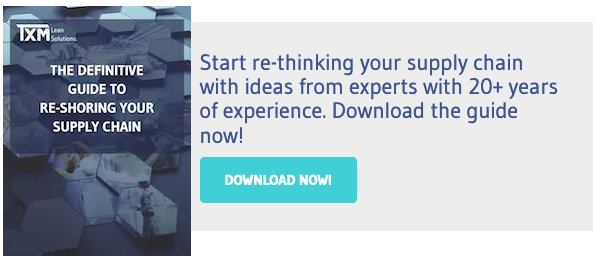
On Time In Full: Achieving Perfect Delivery with Lean Thinking in Purchasing, Supply Chain and Production Planning, about the reasons why manufacturing and distribution businesses fail to deliver on time. In this series of blogs, I am going to talk about the reasons why so many distribution businesses suffer from poor on-time-in-full delivery performance and excessive inventory.
The decision about what products to sell and what products not to sell is one of the most important marketing decisions that most manufacturing and distribution businesses will make. Developing and delivering a product range that best meets the customers’ needs is critical for the success of any product-based business. Actively managing this product range and adapting it to changing customer needs is a vital function in these businesses. Unfortunately, in many cases, I find that businesses have no formal process for product management. Product ranges grow haphazardly and are rarely subject to formal review. This inevitably leads to excessive stock, write-offs, losses, and poor on-time delivery performance.
Why Things Go Wrong
New products get introduced for all kinds of reasons. It can be a specific customer need, it might be to respond to a competitor offering, it might introduce an innovation to the market or it might be aimed at offering a broader range to existing customers (the dreaded “one-stop shop”). Unfortunately, in many businesses I see these decisions are being made all the time and at all kinds of levels in the organization. The result is that the number of products on offer increases and increases over time.
Compounding the problem is that businesses rarely delete or discontinue products. Discontinuing products is difficult. Customers can get very attached to their old products, inevitably the old products bring in some level of sales and percentage margins on the old products might be good. As well the co-ordination of the run out of an old product and run-in of a new one can be complex and brings with it a high risk of obsolete stock.
The result is that we see many businesses with huge product ranges. It is not unusual for us to work with businesses where the combined sales of 50% of their product range represents less than 1% of total revenue.
Why Poor Product Management is a Problem
So, what does it matter if you have 1000 product lines that only represent 1% of your sales? At least they are generating some sales. Customers also might really value the fact that you have the head gasket for a 1968 Bedford truck in stock and your sales team believes that your large range is a key factor in customers’ loyalty to your business.
The problem is that there is a direct correlation between the number of line items that you hold in inventory and the total amount of inventory that you hold. The more items you stock, the more stock you are likely to have. It is also likely that the smaller the annual sales of a product and the lower the frequency of purchase the higher the level of inventory you are likely to need to hold (in terms of days cover). Sales of low volume items tend to be volatile and unpredictable with long periods of little or no sales between infrequent large orders. This means that when the product is ordered there is often insufficient stock and the customer is let down. Costs are then incurred expediting delivery of the out of stock item. As well, keeping track of a large product range is difficult and it is easy for the loss of a customer or a change in the market or technology to make a product completely obsolete.
In summary, poor product management brings with it a spiraling growth in your product range which will increase your inventory, diverting capital from more productive uses. It will also lead to poor on-time delivery and rising costs due to expediting, warehousing costs and continual write-offs of slow-moving and obsolete stock.
TXM Lean Article: Why Distribution Businesses Fail to Deliver On Time In Full
The Product Management Buck Stops Here
The first step to solving the problems in your product range is to recognize that Product Management is a distinct function within your business that someone needs to be accountable and responsible for. In larger businesses, it is normal to have product managers appointed to key product ranges. Product management needs to be seen as a marketing function, responsible for the design, promotion and positioning of each product rather than a sales role, purely focused on winning the next order. In smaller businesses, product management may sit within product development or marketing, but someone needs to be clearly responsible for managing the product range.
Understanding Your Product Range
The first step to improving your product management is to understand your product range. Back in 1896, an Italian economist called Vilfredo Pareto wrote a paper that showed that approximately 80% of the land in Italy was owned by 20% of the people. This has since come to be known as the Pareto Principle or the “80/20 Rule”. A lesser-known fact we that Pareto went on to also postulate that 20% of the pea pods in the garden held 80% of the peas! Since 1896, the Pareto Principle has been shown to apply in many situations.
One of these applications is in understanding your product range. Therefore, a first step can simply be to put all your products in a spreadsheet and rank them in terms of revenue or profit contribution. You will find, like Mr Pareto, that a relatively small number of products are driving the revenue and profit of your business, while at the other end of your range a large number of products are just filling your warehouse and gathering dust.
A more refined way to look at your product range is to use the “Glenday Sieve”, developed by Ian Glenday and described in his book,” Lean RFS”. Ian would suggest ranking all the products in terms of sales or profit and then categorizing them in four categories:
- “Green” products represent the top 50% of sales or profit and these should be always in stock and regularly replenished. These items should never ever be out of stock.
- “Yellow” products make up the next 45% of sales or profit. These products need to be maintained in stock, but where possible you may be able to harmonise them with the “Green” products through simple packaging or design changes.
- “Blue” products make up the next 4% of sales or profit. These products again should be combined with “Yellows” or “Greens” where possible. You should be starting to ask whether these products need to be stock items or whether you can purchase or make them to order. They should be subject to regular review as to whether they remain in stock or are discontinued altogether.
- “Red” products are those that represent the last 1% of your sales or profit. These products are the ones you should be actively working to eliminate from your range, by converting customers over to other products or simply exiting those markets and customers. The idea of walking away from customers or markets really shocks some companies, but if those customers or markets represent a fraction of 1% of your business there is little consequence. It is also likely that the cost to serve those customers will exceed any profit you make, even if the percentage margin on the products seems very attractive.
The Best Way to Avoid Obsolete Products is Not to Introduce Them in the First Place
Products get introduced for all sorts of reasons, and not always good reasons. Many businesses will tell me stories of products that were ordered in bulk because a customer orders them once, only for the customer not to order them a second time or the customer to move to another supplier. Enthusiastic sales staff are often excited by the potential of products they see at an exhibition or that are pitched to them by a supplier and purchase stock only to find that customers are not interested in the new range.
Every business needs a formal process to introduce new products and to delete old ones. The new product introduction process needs a clear business case to be presented. This business case needs to go beyond the potential sales and profits to be generated by the new products to consider what other products in your range might be affected, what inventory or other resources will be required, WHY customers will buy your product rather than the alternative (including your own alternative products), how competitors will respond and what other risks to your business might be involved. The product obsolescence process needs to have tight rules about the run out of old products, particularly where they are to be replaced by a new product. For example, the timing of any promotion of the new product needs to allow time for the old product to be run out. Customers are unlikely to want to buy the old product once they know about the benefits of the new one, leaving you stranded with obsolete stock. Equally the supply of the new product needs to be carefully planned to ensure you have sufficient stock at launch and to support ongoing customer demand. Finally, your obsolescence process needs to clearly define what happens to leftover stock of old products so they don’t hang around and continue to fill up your warehouse or compete for sales with your new product.
Why I Don’t Like “One Stop Shops”
Many businesses pride themselves on offering customers a “one-stop shop”. This means that the company aspires to meet every need a customer might have. I think this is a bit of a lazy approach to marketing and product management. The reality is that customers will always have different suppliers for different products and services. By defining yourself as a “one-stop shop” you will never meet all your customers’ needs. Instead, your customer, ably assisted by your sales team, is likely to lead you in to supplying an ever-growing range of products that have less and less to do with your core business and which you have little ability to properly support. Inevitably as you stray away from your core business your understanding of the product you are buying and selling will diminish. You will introduce more “blue” and “red” products that are dependent on a single customer and when the competitors who specialize in these new product areas respond, you are likely to lose your new business and be stuck with more obsolete stock. Sometimes you can do more good for your business and to your customer by being prepared to say “no” politely and directing the customer to another supplier that specializes in the new area.
Conclusion
Effective product management is a critical function in any product business. It is a distinct function focused on the management of your product range and it is aimed at ensuring that you only sell the products that will deliver the maximum value to your customers and the maximum returns to your business. A well-managed product range will help to ensure that you always have the right stock available at the right time to provide your customers reliable on-time-in-full delivery. It will also ensure you achieve maximum profitability and sales with minimum inventory.





